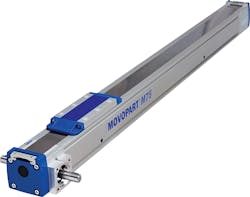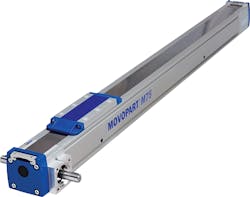There are many industrial applications requiring linear motion, and for most applications, conventional belt or screw drives do just fine. But when loads need to move long distances (more than 40 ft), they sometimes miss the mark. But there are now ways to extend the reach of ball screws by using a new type of collapsible support blocks or combining two screws into one.
Shortcomings of Belt Drives and Screws
Belt drives are a good choice when moving loads linearly distances of 16 ft or less. They are mechanically straightforward. They use pulley drives to generate tension along a belt, which can quickly be brought up to speeds of 33 ft/sec. However, the longer the stroke, the more likely the belt will sag as it cannot maintain tension along its entire length. Plastic or rubber belts commonly used also have a lot of inherent give, which affects the drive’s accuracy. This flexibility can also cause vibrations or springing in the belt, which creates a whipping effect for the carriage and degrades the drive’s precision even more.
Safety is another consideration when choosing belt drives. If the belt on a vertical axis breaks, for example, the load could fall and damage machinery or injure personnel. This is not an issue with screw drives.
Like belt drives, screw drives also have difficulties handling longer strokes. They are commonly provided in lengths of up to 20 ft, but even these need bearing blocks supporting the screw to prevent whipping at rotational speeds around 3,000 rpm. Even at lower speeds, long screws need support to stop them from bending and losing accuracy under their own weight. The extent of this support depends on the load, speed, and the screw’s lead and length.
Bearing-block supports for screw drives traditionally come in pairs typically 0.3 to 1.6 ft apart. They are connected with a rod or wire so that the pair moves together along the axis of linear motion when the moving carriage contacts either support block.
If a screw drive requires longer strokes, more bearing-block pairs are added to support the screw at regular divisions along its length. Having up to three or four pairs working together can be practical, but connecting more than that that within the limited footprint available becomes difficult without fouling other critical components.
Even with these extra supports, if the screw is unprotected it can attract dust and debris, requiring regular cleaning to avoid premature failure of the ball nut. Fortunately, cleaning and reliability issues can be resolved using a covered, sealed screw. The carriage can also be equipped with drilled channels and connected with a grease nipple attached to pre-drilled holes in the carriage. This provides lubrication from a single point with grease entering the ball-guided bearings and ball screw without opening the casing. As the unit never has to be opened, limited amounts of dust or water penetrates to the hardware even in the dirtiest environments.
This file type includes high resolution graphics and schematics when applicable.
Updating the Supports
The first challenge in getting a longer stroke for screw drives, therefore, is creating more support points for longer screws. One way to do this is to use blocks that collapse into each other or separate out when required. Once the blocks reach their position, they stay there to guide and support the screw. With 10, 12, or even 13 of these blocks, support can be provided that gives the ball screw strokes of up to 36 ft. The distance between supports varies according to the size of the unit, but is typically between 1.5 and 3.3 ft.
The screw supports are made of plastic and are designed to “nest” within one another. The supports remain in pockets machined into the extrusion base and, with the exception of the end-screw support, they are locked together. As the carriage moves along the unit, the screw support will be picked up by the arms of an already nested screw support and pushed in the direction of motion. After the carriage passes over that extrusion pocket, a screw support from the other side of the carriage gets dropped off. This can be done because the outer screw support within a nest is always unlocked. A spring mechanism inside each screw support pushes on the extrusion base. It lets the unlocked supports locate and go into the next available extrusion pocket. Once that support gets dropped off, another screw support is freed to go into the next extrusion pocket.
Lengthening the Screw
This nested supports for ball and lead screws lets them go longer distances without bending or whipping while still maintaining 3,000 to 4,000 rpm of rotation speed. But to go beyond 36-ft in length takes a longer screw. However, due to restraints in the raw materials, screws are normally only produced no longer than16 ft. To go further, two screws must be carefully joined to make one longer screw.
Lead and ball screws are manufactured on rolling lines and parts made even on the same line will likely have slightly different lead deviations. To join two parts together, therefore, differences in lead deviation need to be overcome.
For two screws to be successfully joined, the process must start with ball screws that have the smallest possible deviation. The ball screws therefore need to be precisely machined. During machining, heat should not enter the part because it can change the diameter and lead geometry. And changes of a hundredth or even a thousandth of a millimeter can create problems.
After machining, the screws are attached using a tap and hole with minimal deviation between the two leads. This assures there is no difference in lead deviation for the extended-length lead screw from that of a shorter, single-piece screw. Parts are secured using high-strength glue, as any thermal or welded bond would alter the geometry.
Collapsible support blocks and precision manufactured and mated screws means strokes of 35 ft and greater are possible. It also gives users the screw stiffness needed for long strokes and high speeds.
The Need for a Long Reach
Screw drives with long strokes are used in a wide range of industries to provide precise linear motion control. They are used in welding equipment, for example, to accurately position welding nozzles that must reach inside vacuum chambers. Welding on high-quality materials such as titanium, must often be done in a vacuum to avoid oxidizing the metal. Welding long tubes also requires drives with an extended reach.
Several applications within the automotive production lines, such as moving robot-welding arms between stations, also require linear actuators with long strokes. Although speed may not be critical for moving robot arms, it does require long moves and accurate positioning. The auto industry, as well as many others, also has many applications that call for accurately transferring materials between assembly stations.
Making optical cable is a high-speed task that cannot be stopped without jeopardizing the quality of the fibers being produced. Optic cables are spooled onto large reels and when one reel is full, it needs to be replaced as quickly as possible to minimize lost production. Precision and speed are vital to the process efficiency and long screw drives offer both, along with the capability of handling the heavy reels.
Any application requiring the movement of heavy equipment in the vertical plane benefits from the rigidity and failsafe functionality of linear screws. In the aircraft industry, for instance, high-precision cameras used for quality assurance move up and down as the screws carry the heavy weight securely and precisely. In such applications, special ball guides with large-diameter balls take up the dynamic load moments.
This file type includes high resolution graphics and schematics when applicable.





